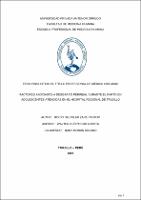Factores asociados a desgarro perineal durante el parto en adolescentes atendidas en el Hospital Regional de Trujillo

Ver/
Descargar
(application/pdf: 612.4Kb)
(application/pdf: 612.4Kb)
Fecha
2020Autor(es)
Zare Pastor, Rocío del Pilar
Metadatos
Mostrar el registro completo del ítemResumen
Material y Métodos: Se realizó un estudio analítico, observacional, casos y controles,
retrospectivo en una muestra de 172 gestantes adolescentes sin desgarro perineal
y 43 gestantes adolescentes con desgarro perineal, atendidas en el Hospital Regional
De Trujillo del 2013 – 2017. Para el análisis de la asociación de variables bivariado se
usó la prueba Chi cuadrado de Pearson y también se midió la medida de riesgo con su
respectivo intervalo de confianza del 95%, del resultado del análisis bivariado se
consideró las que son significativos (p< 0,005) en el análisis multivariado (Regresión
logística múltiple) la cual nos sirvió como modelo predictivo.
Resultados: Nuestro grupo casos y nuestro grupo control fueron relacionados con 5 variables; la episiotomía resultó estar asociada a desgarro perineal como factor protectoren gestantes adolescentes (p= 0.000; OR 0,040); también se encontró una asociaciónsignificativa entre el número de partos vaginales y el desgarro perineal, las multíparastuvieron un riesgo 5 veces mayor para presentar desgarro perineal (p = 0,000; OR: 5,49);por otro lado la duración de la fase activa (p=0,420; OR:0.71), el peso del recién nacido(P=0.239), el personal que atendió el parto (p= 0.122) no estuvieron asociados a desgarroperineal, tampoco fueron factor de protección para desgarro perineal.
Conclusión: Los factores que están asociados a desgarro perineal son el número de
partos vaginales y la episiotomía como factor protector para desgarro perineal. El peso
del recién nacido, la duración de la fase activa, el personal que atendió el parto no están
relacionados a desgarro perineal. To determine the factors associated with perineal tear in adolescents in the
Trujillo Regional Teaching Hospital.
Material and Methods: An analytical, observational study, cases and controls were
conducted, retrospective in a sample of 172 pregnant teenagers without perineal tear
and 43 pregnant teenagers with perineal tear, treated at the Regional Hospital From
Trujillo from 2013 - 2017. For the analysis of the association of bivariate variables,
Pearson's Chi-square test was used and the risk measure was also measured with its
respective 95% confidence interval of the result of the bivariate analysis, the bivariate
analysis was considered. which are significant (p <0.005) in the multivariate analysis
(Multiple logistic regression) which served as a predictive model.
Results: Our case group and our control group were related to 5 variables; the
episiotomy was found to be associated with perineal tear as a protective factor in
adolescent pregnant women (p = 0.000; OR 0.040); a significant association was also
found between the number of vaginal births and the perineal tear, the multiparous
women had a 5 times greater risk of presenting perineal tear (p = 0.000; OR: 5.49); on
the other hand, the duration of the active phase (p = 0.420; OR: 0.71), the weight of the
newborn (P = 0.239), the personnel who attended the delivery (p = 0.122) were not
associated with perineal tear, nor were they protection factor for perineal tear.
Conclusion: The factors that are associated with perineal tear are the number of
vaginal births and episiotomy as a protective factor for perineal tear. The weight of the
newborn, the duration of the active phase, the personnel who attended the delivery are
not related to perineal tear.
Palabras clave
Colecciones
- Medicina Humana [2969]

